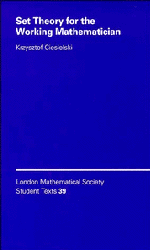Book contents
- Frontmatter
- Contents
- Preface
- Part I Basics of set theory
- 1 Axiomatic set theory
- 2 Relations, functions, and Cartesian product
- 3 Natural numbers, integers, and real numbers
- Part II Fundamental tools of set theory
- Part III The power of recursive definitions
- Part IV When induction is too short
- A Axioms of set theory
- B Comments on the forcing method
- C Notation
- References
- Index
1 - Axiomatic set theory
from Part I - Basics of set theory
Published online by Cambridge University Press: 05 June 2012
- Frontmatter
- Contents
- Preface
- Part I Basics of set theory
- 1 Axiomatic set theory
- 2 Relations, functions, and Cartesian product
- 3 Natural numbers, integers, and real numbers
- Part II Fundamental tools of set theory
- Part III The power of recursive definitions
- Part IV When induction is too short
- A Axioms of set theory
- B Comments on the forcing method
- C Notation
- References
- Index
Summary
Why axiomatic set theory?
Essentially all mathematical theories deal with sets in one way or another. In most cases, however, the use of set theory is limited to its basics: elementary operations on sets, fundamental facts about functions, and, in some cases, rudimentary elements of cardinal arithmetic. This basic part of set theory is very intuitive and can be developed using only our “good” intuition for what sets are. The theory of sets developed in that way is called “naive” set theory, as opposed to “axiomatic” set theory, where all properties of sets are deduced from a fixed set of axioms.
Clearly the “naive” approach is very appealing. It allows us to prove a lot of facts on sets in a quick and convincing way. Also, this was the way the first mathematicians studied sets, including Georg Cantor, a “father of set theory.” However, modern set theory departed from the “paradise” of this simple-minded approach, replacing it with “axiomatic set theory,” the highly structured form of set theory. What was the reason for such a replacement?
Intuitively, a set is any collection of all elements that satisfy a certain given property. Thus, the following axiom schema of comprehension, due to Frege (1893), seems to be very intuitive.
If ϕ is a property, then there exists a set Y = {X: ϕ(X)} of all elements having property ϕ.
- Type
- Chapter
- Information
- Set Theory for the Working Mathematician , pp. 3 - 11Publisher: Cambridge University PressPrint publication year: 1997

